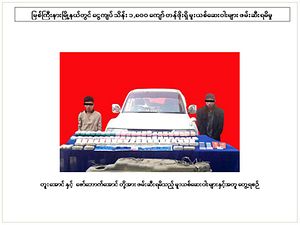On Thursday, the government of Myanmar announced what it claimed as the biggest recorded drug seizure in the country’s history. While the development does deserve mention as part of a wider ongoing crackdown by Naypyidaw, the focus on such record-breaking individual seizures also obscures the massive scale of the problem the country faces as well as the lingering challenges in addressing it.
As I have noted previously, Myanmar remains one of the world’s biggest producers of various kinds of illegal drugs and is a node within the notorious Golden Triangle, long a hub for mainland Southeast Asia’s drug trade. To help stem this problem, Naypyidaw has been taking a series of steps of late, which include not only seizures and arrests, but developing a more integrated national drug policy and cooperating more with international partners on aspects of law enforcement training and intelligence-sharing (See: “China-Myanmar Security Operation Spotlights Big Drug Challenge”).
Though much more remains to be done, these steps at least begin to get at the fundamental reality behind addressing Myanmar’s drug problem. Though it might be easier and politically expedient to focus on the individual punitive actions, which make for good headlines, the real hard work is fashioning a more comprehensive approach to addressing the problem that includes everything from investing more in rehabilitation programs to addressing broader dynamics such as corruption and conflict in areas like Shan state and Kachin state.
Despite that reality, the Myanmar government unsurprisingly also continues to highlight record-breaking seizures, arrests, and large, organized incinerations of drugs. For instance, as I pointed out in an earlier piece, last June, in conjunction with the International Day Against Drug Abuse and Illicit Trafficking, the government touted the fact that the burnings of hundreds of millions of dollars in drugs constituted the biggest burning of seized drugs in the country’s history.
This week saw the government play up yet another instance on this score. On Thursday, the Home Ministry announced that following the arrest of some suspected traffickers, it had seized 30 million meth pills, along with more than two tons of ice and heroin, in a drug bust in Shan state’s Kutkai township.
The seizure is certainly noteworthy within the context of the broader government crackdown. Though some of the figures provided in these instances tend to be questionable, the government said that the total value of what was found was estimated at $54 million, which was one-fifth of the value of drugs seized for the whole of 2017. A senior police officer from the anti-drug department told AFP on condition of anonymity that the bust was “the biggest drug seizure with the largest amount (by value and quantity) in (our) history.”
Yet at the same time, as with other such record seizures, the triumphant images of drug packages stacked high on tables ought to be balanced with a dose of reality given both the massive scale of the problem and the hard work that remains to be done to address it.

































